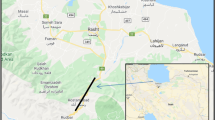Abstract
This paper investigates the arching action occurring in sand dunes and protection embankment of the “on ground” Abou Muharik Tunnel. The precast concrete tunnel is proposed to protect the planned railway line passing from phosphate rich Abou Tartour Area, and through a zone of complex chain of sand dunes in Abou Muharik. Two alternatives are proposed by the designers for the embankment of the tunnel: 1) Using compacted sand for the entire backfill around the tunnel and 2) Embedding a layer of Pneusol within the backfill above the tunnel. The paper presents numerical simulations of both designs using the Finite Elements Program ANSYS. The simulation results give insights on the arching mechanism occurring within the sand dunes and protection layers. Analysis shows that using a Pneusol layer within the protection embankment relieves around 14% of the reaction forces at the tunnel foundation. Eventually, the Marston effect on the tunnel foundation is almost eliminated. The paper also presents a parametric study to optimize the specifications of the Pneusol layer. The study shows that a 10 m wide layer with stiffness that is 20% of that of embankment soil produces most favorable straining actions in the tunnel.
Similar content being viewed by others
References
Akl, A. Y., Abdel Rahman, A., and Hosny, H. (1991). “Structural assessment of cracked large diameter sewer pipes: Proc 2nd International Conference on Foundations and Tunnels, London, 19-21 September 1989 V2, P189-194. Publ Edinburgh: Engineering Technics Press, 1989.” International Journal of Rock Mechanics and Mining Sciences & Geomechanics Abstracts, Vol. 28. No. 6, pp. A360.
Anagnostou, G. (2012). “The contribution of horizontal arching to tunnel face stability.” Geotechnik, Vol. 35, Issue 1, pp. 34–44, DOI: 10.1002/gete.201100024.
Bowles, J. E. (1988). Foundation analysis and design.
Fluent, A. (2009). 12.0 Theory Guide, Ansys Inc, 5.
Getzler, Z., Gellert, M., and Eitan R. (1970). “Analysis of arching pressures in ideal elastic soil.” Journal of Soil mechanics and Foundations Division, ASCE, Vol. 94, No. SM5, pp. 1123–1141.
Jean, P. A. and Long, N. T. (1990). “Creation of arching, pneusol and other techniques.” Proceedings of the International Conference on Instrumentation of Geotechnical Engineering, (Geotechnical Instrumentation in Practice, Purpose, Performance and Interpretation)pp. 663–670.
Lee, C. J., Wu, B. R., Chen, H. T., and Chiang, K. H. (2006). “Tunnel stability and arching effects during tunneling in soft clayey soil.” Tunneling and Underground Space Technology, Vol. 21, Issue 2, pp. 119–132, DOI: 10.1016/j.tust.2005.06.003.
Liang, R. Y. and Yamin, M. (2010). “Three-dimensional finite element study of arching behavior in slope/drilled shafts system.” International Journal for Numerical and Analytical Methods in Geomechanics, Vol. 34, No. 11, pp. 1157–1168, DOI: 10.1002/nag.851.
Long, N. T. (1996). “Utilization of used tyres in civil engineering-The Pneusol ‘Tyresoil’.” Proceedings of the Second International Congress on Environmental Geotechnics, Osaka, Japan, pp. 5–8.
Marston, A. (1930). The theory of external loads on closed conduits in the light of latest experiments, Bulletin 36, Iowa Engineering Experiments Station, Ames, Iowa.
Meguid, M. A., Saada, O., Nunes, M. A., and Mattar, J. (2008). “Physical modeling of tunnels in soft ground: A review.” Tunneling and Underground Space Technology, Vol. 23, No. 2, pp. 185–198, DOI: 10.1016/j.tust.2007.02.003.
Potts, V. J. and Zdravkovic, L. (2010). “Finite-element study of arching behavior inreinforced fills.” Proceedings of the ICE–Ground Improvement, Vol. 163, Issue 4, pp. 217–229, DOI: 10.1680/grim.2010.163.4.217.
Spangler, M. G. (1964). “Protection of underground structures by arch action associated with the imperfect ditch method of construction.” Proceedings of the Symposium on Soil Structure Interaction, University of Arizona, Tucson, Arizona.
Spangler, M. G. and Handy, R. L. (1973). Loads on underground conduits, Soil Engineering, 3rd Edition, pp. 658–686.
Terzaghi, K. (1936). “Stress distribution in dry and in saturated sand above a yielding trap-door.” Proceedings, First International Conference on Soil Mechanics and Foundation Engineering, Cambridge, Massachusetts, pp. 307–311.
Terzaghi, K. (1943). Theoretical soil mechanics, Vol. 18, New York: Wiley.
Tien, H.-J. (1996). A literature study of the arching effect, MSc Thesis, Civil Engineering Department, MIT, Cambridge, MA.
Vermeer, P. A., Punlor, A., and Ruse N. (2001). “Arching effects behind a soldier pile wall.” Computers and Geotechnics, Vol. 28, pp. 379–396, DOI: 10.1016/S0266-352X(01)00010-6.
Whitman, R. V., Getzler, Z., and Hoeg, K. (1962). Static tests upon thin domes buried in sand, MIT Research Project Report No. R62-41, December 1962.
Whitman, R. V., Getzler, Z., and Hoeg, K. (1963). “Tests upon thin domes buried in sand.” Journal of the Boston Society of Civil Engineers, pp. 1–22.
Author information
Authors and Affiliations
Corresponding author
Rights and permissions
About this article
Cite this article
Akl, S.A., Metwally, K.G. Optimizing arching creation for Abou Muharik Tunnel in Egypt using numerical analysis. KSCE J Civ Eng 21, 160–167 (2017). https://doi.org/10.1007/s12205-016-0428-2
Received:
Revised:
Accepted:
Published:
Issue Date:
DOI: https://doi.org/10.1007/s12205-016-0428-2




